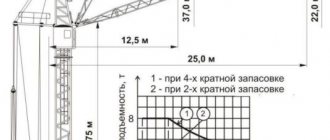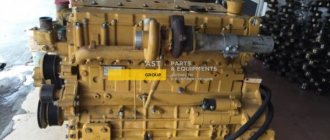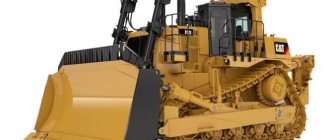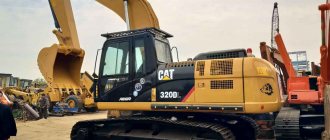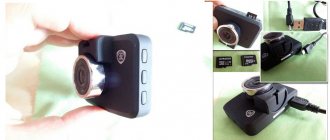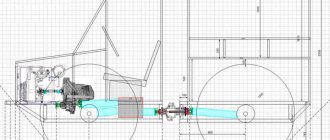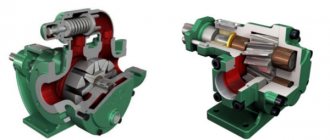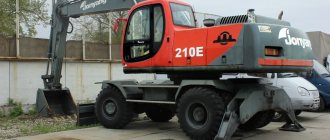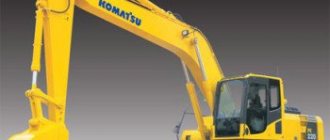A hydraulic hammer is a removable working equipment of hydraulic excavators, which is hung on a rotating boom or its handle.
An easily removable mechanism allows the operator to replace the hammer himself, for example, a light one with a heavy one, right on the construction site in ten minutes using standard tools. If the excavator uses a quick-release mechanism, then replacing attachments takes a couple of minutes. Heavy excavators use hydraulic quick-release mechanisms.
On a hydraulic hammer, its own working tools are also removable - destructive chisels, regular and conical peaks, simple and hydraulic wedges - both longitudinal and transverse.
Some models ensure the destruction of durable structures even under a layer of water. For this purpose, their structural components are protected by waterproof elements.
Classification of hydraulic hammers
It is called a hydraulic hammer because it is driven by the standard hydraulics of the mechanism and does not require any additional energy sources. It is a quick-release attachment for excavators, loaders, pile drivers, manipulators, and other boom construction equipment used for dismantling work.
The main parameter for the effectiveness of a hydraulic hammer is the impact force measured in J. Depending on its indicator, equipment is divided into three categories:
- Small class (from 400 to 1500 J);
- Middle class (from 1500 to 3500 J);
- Heavy class (more than 3500 J).
A little history
A hydraulic hammer is an additional attachment for excavators, which performs impact actions using the hydraulic system of special equipment. Most often, hydraulic hammers are equipped with different replaceable attachments for different jobs. The operating principle is reminiscent of a pneumatic jackhammer, which was previously used by road workers to carry out repair work.
The hydraulic hammer, as an additional attachment, began to be used back in Soviet times. The first hydraulic hammers did not have very high power, but this did not become an obstacle to their development. This equipment was actively used for the reason that it did not require an additional unit of equipment. Even a conventional pneumatic jackhammer required a huge compressor and a separate person to operate it. But the hydraulic hammer could be installed on an excavator, which was already present in most construction or repair work.
Every year, hydraulic hammers have been actively developing and improving. They began to have higher impact force and more compact sizes. If the first hydraulic hammers took hours to install on an excavator, modern ones can be installed in a few minutes. Nowadays they have many areas of application.
Small class
Attachments designed for dismantling work in cramped conditions, and not requiring high power applied force.
Advantages:
- possibility of use in hard-to-reach places;
- compact size, light weight;
- Possibility of use when working indoors;
- the mechanism has two modes of operation: shock and shock-rotational;
Flaws:
- insufficient impact power to carry out all types of dismantling work;
- lower performance.
Hydraulic hammers of this class are used for:
- destruction of ice and a layer of frozen soil T = 20 cm;
- dismantling asphalt pavements;
- destruction of concrete screeds T = up to 30 cm;
- drilling holes in brick and concrete structures;
- compaction and soil compaction.
The best small hydraulic hammers
Among the leaders are the products of the conglomerate of manufacturers Atlas Copco AB and Krupp Berco Bautechnik. The range of niche equipment weighing from 35 to 415 kg is designated by the letters SB. The advantage of the line is that the equipment can be mounted on excavators and loaders weighing from 500 kg.
The most common models:
Model SB 52
Weight - 55 kg, suitable for use on carriers weighing from 0.5 tons
hydraulic hammer SB 52
Advantages:
- despite its size, it is superior in power to portable and stationary jackhammers;
- adapted to work with carrier oil consumption in the range from 12 to 27 l/s.
Flaws:
- not detected.
Model SB 552
Weight 520 kg, suitable for mechanisms weighing from 5 tons.
hydraulic hammer HSB 552
Advantages:
- power corresponding to some middle class models;
- adapted for operation of oil pumps with flow rates from 65 to 115 l/min.
Flaws:
- not detected.
In this segment, the products of the Japanese company Furukawa Rock Drill Co. also deserve attention. Ltd, brand FRD.
Lightweight and easy to operate are the main distinguishing characteristics of hydraulic hammers produced by this company. Hammers in the weight range of 67 - 283 kg are equipped with internal damping elements, L-shaped side plates, and an insulated mounting plate, providing noise absorption and vibration damping. Equipped with a hydraulic control valve to synchronize the oil pressure of the attachment and the carrier mechanism.
Hydraulic hammer Furukawa F1
Hydraulic hammer weight: 67 kg, impact energy: 160 J, impact frequency: 1250 beats/min, nozzle diameter: 36 mm, oil consumption: 20 l/min.
Hydraulic hammer Furukawa F1
Advantages:
- low noise;
- presence of a synchronizing valve.
Flaws:
- not detected.
Middle class
The most common type of this type of equipment, its popularity is ensured by its versatility, fairly compact size, and the ability to perform the vast majority of dismantling work. Hydraulic hammers of this class are available for all types of work performed previously and additionally:
- destruction of concrete and reinforced concrete structures;
- crushing granite and marble rocks M 600;
There are restrictions when working at sites with high building density, based on the power of the equipment used: no more than 2,500 J.
Advantages:
- versatility of use;
Flaws:
- not detected.
The best mid-range hydraulic hammers
Among the variety of mechanisms in this category, noteworthy are the products of Nippon Pneumatic, a Japanese company that appeared on the market of attachments in 1961 and operates under the NPK brand. Improving the design of the diaphragm accumulator allowed the company to organize the production of a new GH line of middle-class hammers with an increase in impact force by 30% with the same product weight.
Hydraulic hammer manufactured by NPK
Weighing 1900 kg, impact energy 4000 J.
Hydraulic hammer NPK
Advantages:
- with low weight, it has the power of heavy class models.
Flaws:
- fixed oil consumption requires the selection of an appropriate mechanism.
Hydraulic hammer F19
Another representative of the family, produced by another Japanese company Furukawa Rock Drill Co. Ltd. (FRD). Its mechanisms are distinguished by the presence of a hydraulic system control valve, which allows synchronizing the parameters of the hammer and the mechanism.
Weight: 1260 kg, impact energy 3579 J, oil consumption: 155 l/min.
Hydraulic hammer F19
Advantages:
- hydraulic synchronization allows use on any carrier of the appropriate weight;
- with a small mass it has the maximum impact force in its category.
Flaws:
- not detected.
Heavy class
Hydraulic hammers of this class are designed to perform work that was previously carried out using blasting.
Used in production:
- quarry work;
- demolition of particularly strong reinforced concrete structures: bridges, bunkers, hydraulic structures.
Due to the large diameter of fragments and vibration, the use of heavy-duty hydraulic hammers requires additional precautions.
Advantages:
- maximum efficiency;
- the ability to perform any dismantling, crushing and crushing tasks.
Flaws:
- restrictions in use due to safety precautions, dimensions and carrier mechanisms.
The best heavy-duty hydraulic hammers
HM 4000CS Krupp
The undisputed leader in the segment is the Krupp HM 4000CS. When producing its products, the company uses the principle of stepwise sealing, which allows to significantly extend the service life of the impact piston.
HM 4000CS Krupp
Advantages:
- has the greatest impact power in its class;
- operates autonomously from the carrier’s hydraulic system;
- Possibility of operation in underwater and underground conditions, resistant to heavy dust.
- the presence of a quick-release adapter;
Flaws:
- high price.
The heavy class has colossal energy, which allows it to be used to solve other problems that are not typical for its younger brothers:
Features of Rammer equipment
Rammer has been making attachments for over 30 years and does a great job. It supplies the market with a large number of modifications of hydraulic hammers, as well as spare parts and tools for them. Rammer hydraulic hammers are modern, reliable and powerful equipment at affordable prices, with which you can increase the productivity of work and achieve maximum profitability. The devices have permission from Rostechnadzor, and quality management at the manufacturer’s enterprise complies with the international standard ISO 9001.
Rammer hydraulic hammers are characterized by a high degree of reliability and long service life. It is not without reason that the manufacturer provides a lifetime warranty for certain types of its products (in particular, hydraulic hammers Rammer BR2155, BR3288, BR2577 and BR4099). Such confirmation of quality gives rise to confidence in the equipment that you have chosen for carrying out certain construction work.
Hydraulic hammers for driving piles
The principle of operation of this type of hammer is the mechanical impact on the head of the pile, leading to its immersion in the soil.
Adjusting the impact force allows you to select the required power of the recess and avoid destruction or deformation of the head of the immersed element.
Advantages:
- equipped with a cooling system allowing round-the-clock operation of the mechanism;
- the installation has a shock-absorbing system that reduces mechanical impact on the soil and noise impact on the environment;
- long operational service life of 15 - 20 years.
Flaws:
- Quite a lot of noise and vibration.
The best driving hammers
Similar equipment of all categories is produced by the Finnish company Junttan, a world leader in the development of technologies and equipment for piling work.
Junttan PM25L Heavy Class Installation
Designed for driving reinforced concrete piles. It is equipped with a side mounted rotor to produce “leading” drilling, facilitating immersion in dense soils. L=16m, section 300x300; 350x350; 400x400, weight 6,400 kg.
Junttan PM25L Heavy Class Installation
Advantages:
- low noise and vibration levels;
- high performance and ease of operation;
Flaws:
- decrease in productivity when the weight of the pile exceeds the weight of the hammer by more than 3 times.
Hydraulic hammers for driving piles
Hydraulic vibratory loaders are designed to compact soil to the required characteristics by driving a pile. With replaceable attachments, they successfully cope with reinforced concrete and wooden piles, sheet piles, shell piles, plastic and composite options.
The principle of operation of the mechanism: under the pressure of hydraulic fluid, a group of eccentrics creates vibration and transmits it through the pile holder to the immersed element. The thixotropic properties of the soil change its characteristics in the vertical and horizontal planes of contact with the pile body, reducing the friction force and ensuring the immersion of the pile element under the influence of its own weight and the mass of the vibratory driver.
Advantages:
- low noise, minimal environmental damage;
- high vibration amplitude allows you to speed up the labor-intensive process of work;
- adjustment of the frequency range allows you to select an individual immersion mode depending on the properties of the soil and material and the shape of the pile;
- The operating features of the mechanism make it possible not only to deepen, but also to remove submerged piles.
Flaws:
- not detected.
The best hydraulic hammers vibrators
Delta VM600SG
Features a high immersion speed. The small dimensions of the mechanism allow the use of piles of maximum sizes. A set of holder attachments allows you to immerse tongues, I-beams, channels, pipes, and, in combination with a side grip, remove them.
Delta VM600SG
Advantages:
- high-quality service, including staff training;
- automatic tilt angle control;
- Compatible with all media on the market.
Flaws:
- not detected.
Rules for selecting a hydraulic hammer
Before choosing a hydraulic hammer, you need to understand the following rules, non-compliance with which can lead to premature failure of the mechanism, or an emergency during work.
Recommendations for choosing a hydraulic hammer
- selection by weight. Construction equipment intended for using a hydraulic hammer as an attachment comes in two types: wheeled and tracked. When selecting a hammer for a wheeled mechanism, it is necessary to take into account that its weight should not exceed 10% of the weight of the carrier and be equal to the lifting capacity of the boom at maximum reach, otherwise the working mechanism may overturn. The calculation formula for a caterpillar tractor is the same, but the tolerances are more flexible due to better stability and a low center of gravity.
- selection based on the characteristics of the circulation of working fluid in the hydraulic system of a technical device. The working pressure of the hydraulic fluid of the hammer must correspond to that of the excavator. The volume of pumped oil should not exceed the capacity of the hydraulic system, otherwise failure of the expensive oil pump cannot be avoided.
- The tasks facing the hydraulic hammer and the conditions in which it will be operated are especially important in cases where the mechanism is intended to be rented out, and the factors listed above are simply not known.
- Every task has its own cost, and therefore, in the operation of a mechanism, cost is of paramount importance. The last, but very important factor of choice is the price of the hydraulic hammer.
Maintenance of Rammer hydraulic hammers
QS Group provides after-sales service for Rammer hydraulic hammers, offering a wide range of work:
- Commissioning and warranty;
- Warranty and post-warranty repairs;
- Routine maintenance (according to operating hours);
- Diagnostics of the hydraulic system of the base machine, adjustment of operating parameters;
- Departure of service specialists to the customer’s site, as well as diagnostics and repair of equipment at our company’s repair base.
To carry out all maintenance work on hydraulic hammers, we use the most modern equipment, as well as the extensive experience of our service specialists.
Attachments for hydraulic hammers
Hydraulic hammers of all categories, in addition to the listed advantages, have one more thing: replaceable attachments, which allow you to significantly expand the range of work performed and increase their efficiency.
Types of nozzles:
- for destruction;
- for compaction.
Breaking attachments
They are a metal rod made of wear-resistant steel. Used for dismantling, crushing and crushing structures; Depending on the task at hand, they differ in the type of tip: chisel and chisel are divided into:
Pike, with a cone-shaped tip
Advantages:
- easy penetration into the material;
Flaws:
- labor-intensive extraction, possibility of jamming in the rock.
For this reason, nozzle manufacturers have developed new models of peaks, giving the tip, instead of a cone, the shape of a three or four-sided pyramid. Longitudinal cracks form on the traverse of the edges, enhancing the destructive effect and minimizing the possibility of jamming.
lance hammer attachment
Chisel
When splitting individual large fragments, even durable minerals, a chisel-shaped tip has proven itself to be effective. Two perpendicular faces create longitudinal cracks, accelerating rock fragmentation.
hydraulic hammer attachment wedge
Areas of application
Rammer hydraulic hammers are successfully used in a whole range of construction works:
- dismantling of structures;
- opening of underground communications;
- opening of asphalt concrete pavement;
- earthworks (destruction of frozen ground, soil compaction);
- crushing of hard rocks;
- driving piles.
In the cold season, hydraulic hammers are practically indispensable for working with frozen soil. The environmental friendliness and energy efficiency of Rammer hydraulic hammers allows them to be used as a highly efficient alternative to diesel devices.
